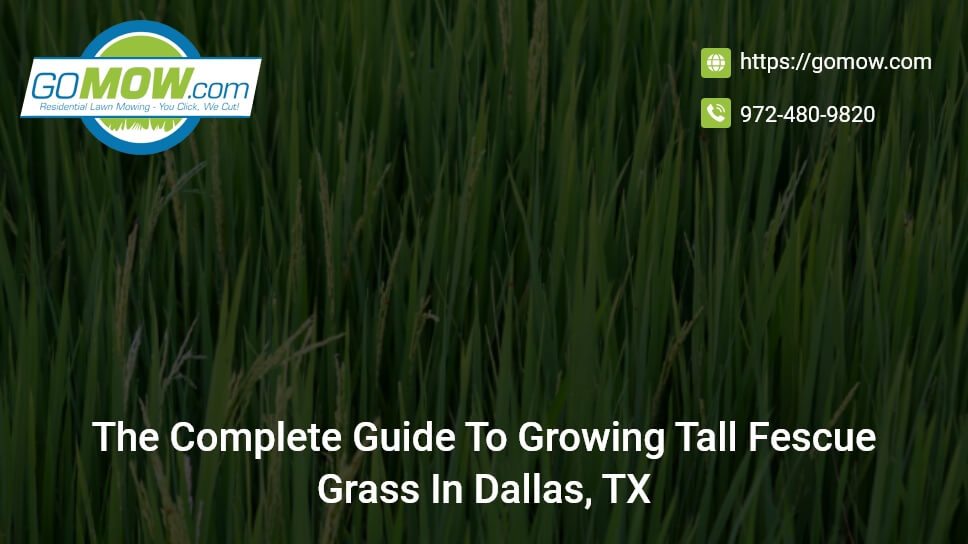Characteristics of Tall Fescue
Tall Fescue as the name implies is a tall cool season grass known to withstand heat. It is drought tolerant, requires little maintenance and watering from any lawn service in Dallas. Mowing is only recommended after the lawn has been established for a while.
Different Types of Fescue Grass
Tall Fescue comes in many different forms or species. Many tall fescues have been created for use as grazing animal pasture feed. The turf lawn varieties are generally dwarf forms of F. arundinacea, often used in golf courses.
In the cool season zones, Tall fescue grass seed is often blended with other cool-season grasses such as Kentucky bluegrass to create a hybrid that combines the strengths of both grasses.
For example, Kentucky bluegrass tolerates foot traffic well, whereas fescue tolerates shade better. When combined, the outcome is a grass type that can handle foot traffic while being tolerant to shade.
Below are species of Tall Fescue as we know them:
-
Black Beauty:
A tall fescue blend known for its disease resistance. If you’re in a mold-prone area, planting the Black Beauty variant of Tall Fescue is a game changer.
-
Dense Shade Mix:
A fescue blend known for its shady performance and rapid development.
-
Fescue chewing:
This species of Tall Fescue grows upright with delicate, thin blades that are drought resistant. If water irrigation is challenging, Fescue chewing is a species to consider on your lawn yard.
-
Creeping red fescue:
This species of Tall Fescue has a deep green color with delicate blades that tolerate shade.
-
Hard fescue:
This particular Tall Fescue is a highly fertile grass that requires less mowing and is widely used on golf courses. It’s tough and slow-growing which makes it perfect for such needs.
-
Kentucky 31:
This specie of Tall Fescue is has the following features – coarse; tolerates heavy traffic; shade tolerant; drought tolerant
-
Sheep fescue:
Sheep fescue is a Tall Fescue that has been created for enhancing soil conditions and helps to avoid erosion. It’s mostly used in areas where erosions are a threat.
Factors that Affect the Growth of Tall Fescue
Light Permeation
Tall fescue grass may grow in full sun to partial shade. As your lawn care service in Dallas might mention, these grasses tolerate shade and grow well in regions where it is too hot for cool grasses but too cold in the winter for warm-season grasses.
Soil Condition
These grasses may grow in a variety of soil conditions. Deep roots may locate nutrients and moisture in practically any soil type. It’s a tough, hardy grasses that can survive in tough soil conditions.
Water Access
Weekly irrigation with 1 to 1 3/4 inches of water is desirable but not required. Watering should be done to a depth of 4 to 6 inches. Tall fescue grass is drought resistant due to its extensive roots. When there’s not enough rain, only water.
Humidity and temperature
Tall fescue has a high cold tolerance, yet it is susceptible to winter damage in the coldest parts of the northern United States and Canada. It can endure high temperatures if given enough water, but extreme heat combined with drought can kill it.
Fertilizer Application
Tall fescue grass thrives when fertilized once a year with 3 to 4 pounds of nitrogen-based fertilizer per 1,000 square feet of lawn.
Lawn Mowing
For your lawn mowing service in Dallas, cool season grasses, such as tall fescue, should be mowed at 3 to 4 inches in length, with no more than one-third of the entire length of the grass blades removed. Keeping lawn grasses relatively tall is the greatest approach to keep weeds at bay.
Pest and Diseases that Affect Tall Fescue
Brown patch and Snow Mold are two fungal diseases that affect Tall Fescue grass. The symptoms usually occur around midsummer, and the only way to treat them is to remove the damaged spots and reseed them completely. Early treatment is very key in tackling these disease conditions as soon as they’re present. To treat early, early detection is the way forward. Employing a lawn mowing service in Dallas will help your Dallas Tall Fescue lawn avoid disease outbreaks on time.
Challenges Experienced with Tall Fescue
One of the most common issues with tall fescue grass is that it can out-compete other grasses in a mixed-grass lawn. There are at least two possible control approaches for tall fescue. The first is for individuals who don’t mind utilizing chemicals, while the second is for those who like to stay organic.
In addition to tall fescue, you can choose ryegrass, Kentucky bluegrass, or even blue fescue for a well-seeded lawn with a consistent appearance. Work with a lawn service in Dallas to decide what works best for your specific lawn yard.
How to Grow Tall Fescue from Seed to Establishment
Tall fescue grass is best grown from seed for best results. Plant when the soil temperature is between 50 and 65 degrees Fahrenheit (or 60 to 75 degrees Fahrenheit during the day). If feasible, seed it in bare soil to a depth of about 1/2 inch. While you wait for the seeds to germinate, keep the soil moist. Before mowing for the first time, wait until the blades are 4 inches or longer in length.
Avoid using pre-emergent herbicides for 90 days after seeding as doing so can damage the young grass. If there are concerns, consult lawn care in Dallas to investigate them.
Conclusion
Tall Fescue is a resilient, drought resistant, disease resistant grass species that comes in various variants. Homeowners in cool season areas can choose this beautiful lawn grass species and be rest assured that it would do well.
For all your lawn mowing needs, GOMOW Lawn Care Service is available to deliver an experienced lawn service in Dallas.
Contact us to get a FREE QUOTE. https://gomow.com/get-quote/.
